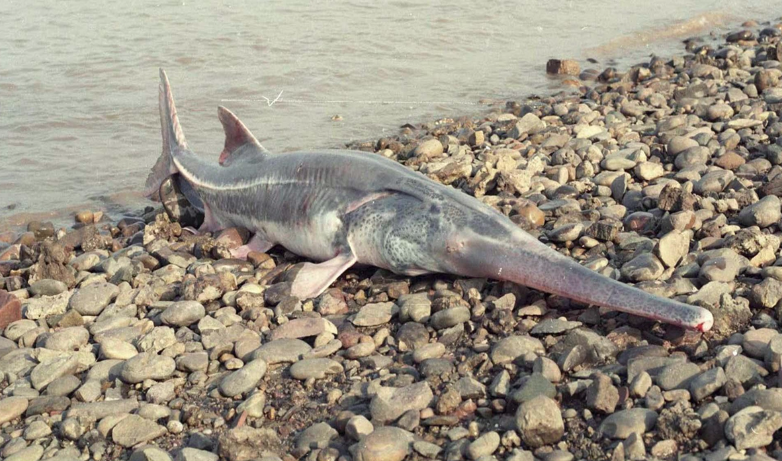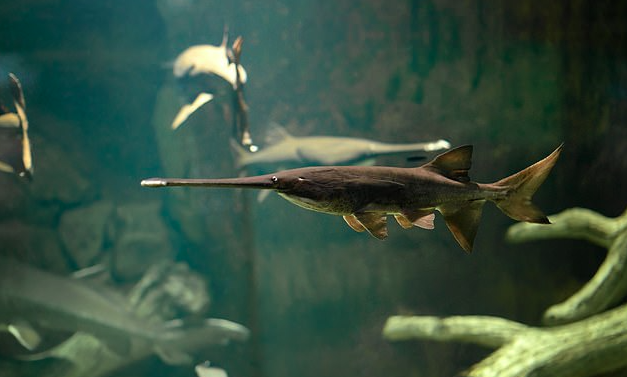In July 2022, the Chinese paddlefish was officially recognized as extinct by the IUCN. Delve into this page to explore the intriguing details of this sizable and migratory fish, as well as the various factors that led to its unfortunate demise.
Chinese Paddlefish

The Chinese paddlefish, also referred to as the Chinese swordfish, was a formidable aquatic creature inhabiting the Yangtze and Yellow River basins in China. Belonging to the paddlefish family, Polyodontidae, this species now stands as the sole survivor, as the American paddlefish remains the only living representative of this ancient lineage.
Size & Physical Description
The Chinese paddlefish was characterized by its remarkable elongated snout, known as the rostrum. Paddlefish, in general, derive their name from the paddle-like shape of their rostrums.
Unlike the broad and paddle-shaped rostrum of the American paddlefish, the Chinese paddlefish had a slender and sword-like rostrum.
The significant size of the rostrum is believed to be an evolutionary adaptation that enhanced the Chinese paddlefish’s electroreceptive capabilities. Similar to sharks, this fish possessed the remarkable ability to detect electrical fields generated by the muscles of its prey.

The Chinese paddlefish was a sizable aquatic creature known for its impressive size, often reaching lengths of about 10 feet or 3 meters. Although there are records of some specimens growing up to 23 feet or 7 meters long. One striking feature of this fish was its rostrum, which occupied a significant portion, up to a third, of its total body length.
With its dorsal and anal fins positioned towards the back of its body, the Chinese paddlefish boasted a sleek and streamlined appearance. Its upper body displayed a brown-gray hue, while the undersides were white. The fish had a smooth and scaleless body, except for the presence of scales on its tail.
One notable characteristic of the Chinese paddlefish was its ability to extend its jaws forward, enabling it to seize prey. Within its jaws, numerous small teeth were found, aiding in capturing and consuming food.
Family & Related Species
The Chinese paddlefish was a member of the Polyodontidae family, known for its distinct paddle-shaped snout. Unfortunately, this species has recently become extinct, leaving behind only one surviving member of the family: the American paddlefish, scientifically known as Polyodon spathula.
There are four other paddlefish species that are only known from their fossils.
The paddlefish’s closest living relatives are 27 sturgeon species, which belong to the Acipenseridae family.
Both paddlefish and sturgeons have skeletons primarily made of cartilage instead of bone, even though they are classified as ray-finned, bony fish under the Actinopterygii class. They also possess electroreceptive organs.
In terms of lifestyle and diet
The Chinese paddlefish followed anadromous behavior, hatching in freshwater and migrating downstream to brackish estuaries where freshwater meets saltwater, before returning upstream to reproduce. Spawning typically occurred when the fish were 8 to 12 years old.
The Chinese paddlefish was a strong swimmer and predominantly inhabited the middle to lower levels of large rivers.
As a piscivore, the Chinese paddlefish fed on small and medium-sized fish such as anchovies, gobies, and catfish. It relied on its electroreceptive abilities to hunt for prey.
Extinction

The Chinese paddlefish met its demise as a result of excessive fishing and the degradation of its natural habitat, particularly due to the construction of dams along its migration route.
The decline of this species gained momentum towards the end of the 20th century, with the last sighting of the Chinese paddlefish in the Yellow River basin occurring in the 1960s. In the Yangtze basin, catches of Chinese paddlefish amounting to 25 tonnes per year persisted until the 1970s, underscoring the alarming pace of its decline.
The construction of the Gezhouba Dam in 1981, situated in the middle section of the Yangtze River, acted as a barrier that prevented the paddlefish from migrating upstream to spawn. Although the Chinese paddlefish had already begun its decline, the construction of the Gezhouba Dam and other similar structures are widely regarded as major contributors to the ultimate extinction of this fish.
Efforts to breed the species in captivity proved unsuccessful, and the last known living Chinese paddlefish was documented in 2003. In 2019, an assessment conducted by the IUCN yielded no evidence of any surviving individuals, leading to the official declaration of the Chinese paddlefish as extinct in July 2022.